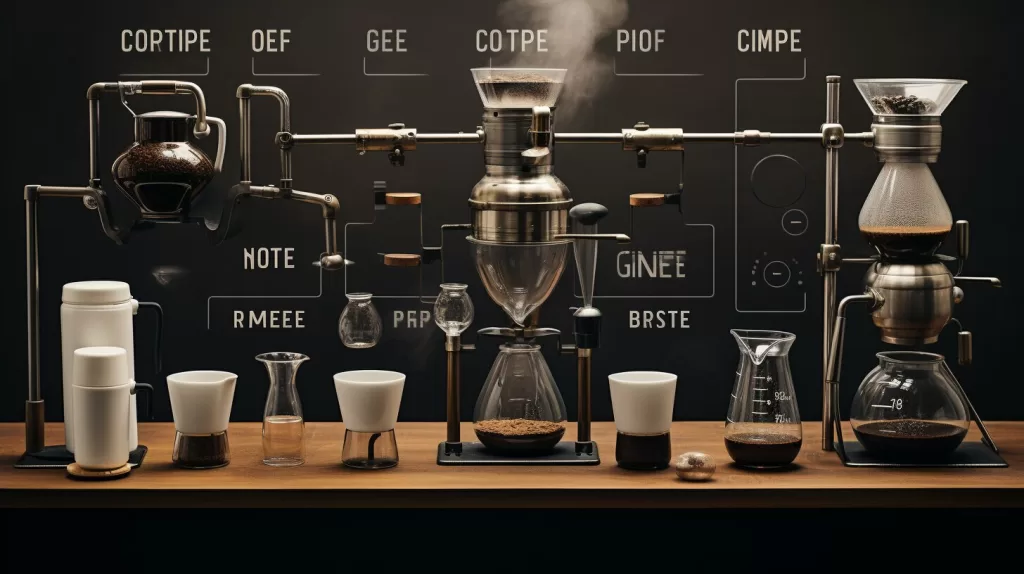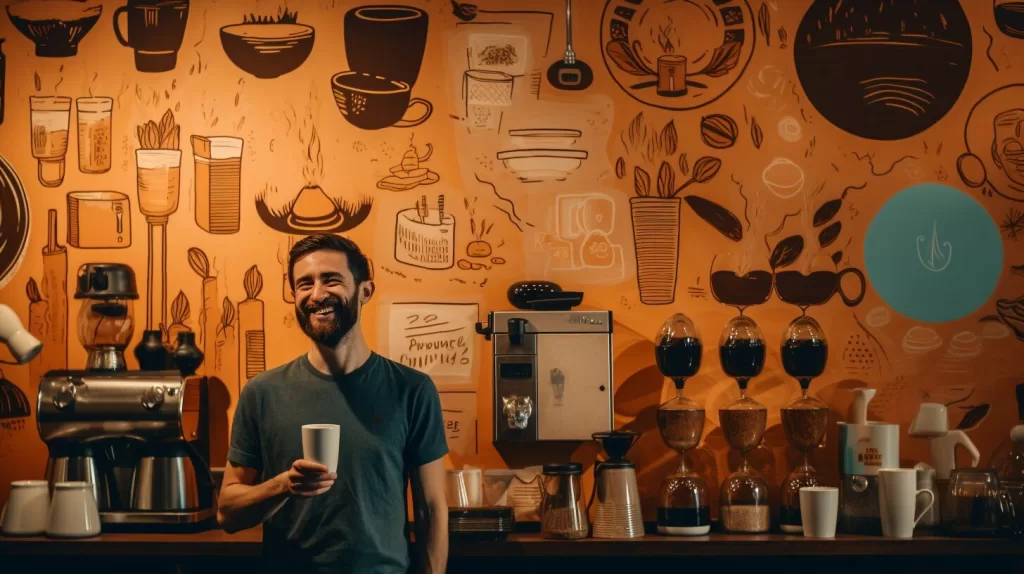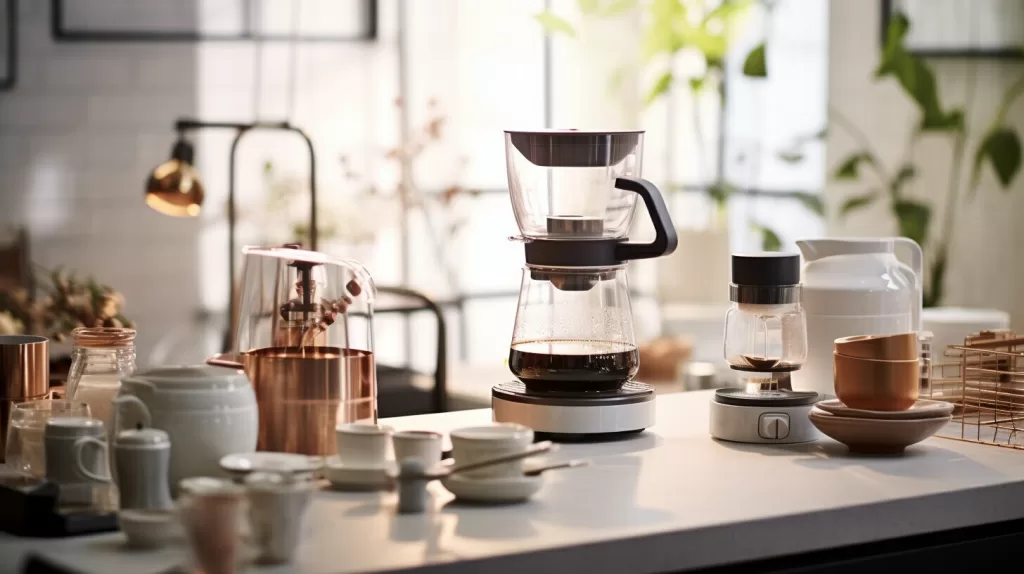Welcome to our comprehensive guide on coffee brewing troubleshooting. Whether you’re a seasoned coffee lover or just starting out, brewing the perfect cup of coffee can sometimes be challenging. From weak coffee to bitter or over-extracted coffee, we’ve got you covered. In this guide, you’ll learn how to fix coffee brewing problems and achieve the perfect cup every time.
Key Takeaways:
- Coffee brewing troubleshooting is essential for anyone who wants to consistently brew the perfect cup of coffee.
- Factors that influence coffee extraction, such as grind size, water temperature, and brew time, are crucial to understand to diagnose and fix brewing problems.
- Common coffee brewing issues include uneven extraction, sediment in the cup, and problems with brewing equipment.
- Mastering various coffee brewing techniques, such as pour-over, French press, espresso, and cold brew, is crucial for elevating your coffee brewing skills.
- Remember, brewing the perfect cup of coffee is an art, and troubleshooting is a valuable tool in your arsenal.
Understanding Coffee Extraction
Before we dive into troubleshooting coffee brewing problems, it’s important to understand the process of coffee extraction. Extraction is the process of dissolving soluble compounds from coffee grounds into water to create the final cup of coffee.
The factors that influence extraction include:
- Grind size
- Water temperature
- Brew time
- The amount of coffee used
Each of these factors plays a crucial role in determining the taste of your coffee. Too much extraction can lead to bitter coffee, while too little extraction can result in weak coffee. Understanding the optimal balance of these factors is key to troubleshooting coffee extraction issues.
Controlling Grind Size
The size of your coffee grind is one of the most important factors in coffee extraction. A finer grind will result in more surface area, which allows for faster extraction. A coarser grind will extract more slowly.
If your coffee is tasting weak, try adjusting your grind to become finer. If your coffee tastes too bitter, then try using a coarser grind. Experiment with grind size until you find the perfect balance for your taste preferences.
Monitoring Water Temperature
The ideal water temperature for coffee extraction is between 195°F and 205°F. If your water temperature is too low, then your coffee will be under-extracted. If your water temperature is too high, then your coffee will be over-extracted.
Using a thermometer ensures that you have the correct water temperature for brewing coffee. If you do not have a thermometer, let the water come to a boil and then let it cool for about 30 seconds before pouring.
Adjusting Brew Time
Brew time is the amount of time that the water is in contact with the coffee grounds. If your coffee is weak, then try increasing the brew time. If your coffee is bitter, then try decreasing the brew time.
You can also adjust the brew time by changing the amount of coffee used. Using more coffee grounds will increase the brew time, while using less coffee grounds will decrease the brew time.
By mastering the factors that influence coffee extraction, you can diagnose and troubleshoot any coffee brewing problems that may arise.
Troubleshooting Weak Coffee
Is your morning cup of Joe lacking in flavor or strength? Don’t fret, as weak coffee can be quite a common issue. Let’s explore the potential causes and provide practical solutions to achieve a bolder, more enjoyable brew.
Possible causes of weak coffee:
- Incorrect coffee-to-water ratio
- Using stale coffee beans
- Grind size too coarse
- Water temperature too low
- Brew time too short
Solutions for weak coffee:
1. Adjust your coffee-to-water ratio: A common mistake is using too little coffee in proportion to water. Try using a ratio of 1:15, which means one part coffee to 15 parts water. For example, for 1 cup of coffee (8 ounces), use 0.5 ounces or 14 grams of coffee and 7.5 ounces or 221 milliliters of water.
2. Experiment with different brewing methods: Some brewing methods, such as French press or pour-over, allow for more control over extraction and can enhance the flavor and strength of your brew.
3. Use fresh, high-quality coffee beans: Stale or low-quality beans can result in a weak and lackluster coffee taste. Invest in freshly roasted, high-quality beans for a richer, more flavorful coffee.
4. Adjust your grind size: A grind size that’s too coarse can lead to under-extraction and weak coffee. Try using a finer grind size to increase extraction and enhance the flavor.
5. Increase water temperature and brew time: Hotter water and longer brew time can lead to a more extracted, stronger coffee flavor. Experiment with gradually increasing the temperature and brew time until you find your desired level of strength and flavor.
By troubleshooting weak coffee using these methods, you’ll be able to enjoy a richer, bolder cup that’s sure to perk up your morning routine.
Fixing Coffee Bitterness
There’s nothing more disappointing than taking a sip of your coffee only to be met with a bitter taste. Fortunately, there are a few methods to balance out the flavor.
Adjusting your brewing time
One potential cause of bitterness is over-extraction, which can occur if you leave your coffee brewing for too long. To fix this issue, try reducing your brewing time by a few seconds. Keep an eye on the clock and taste your coffee frequently to find the sweet spot.
Using different coffee bean varieties
The beans themselves could be contributing to the bitter taste. If you’re using dark roast coffee, try switching to a medium or light roast. The longer roasting process of dark roasts can result in a more bitter flavor profile.
Incorporating specialty additives
You can also try adding a pinch of salt or a small amount of butter or cream to your coffee. These ingredients can help balance out the bitterness by adding a touch of sweetness or richness.
No matter the cause of the bitterness, experimenting with these techniques can help you achieve a smoother and more enjoyable cup of coffee.
Troubleshooting Coffee Over-Extraction
Coffee over-extraction can be a common issue, resulting in a harsh, bitter taste. If you’re experiencing this problem, there are several potential causes to consider.
One possible reason for over-extraction is using too fine of a grind. When the coffee particles are too small, the water has difficulty passing through, resulting in a prolonged extraction period and a bitter taste. Try adjusting your grinder to produce a coarser grind.
Another factor that can lead to over-extraction is water temperature. If the water is too hot, it can cause the coffee to over-extract quickly. Try lowering the temperature to between 195-205°F (90-96°C).
Brew time is also a crucial component in coffee extraction. If your coffee is over-extracted, you may be leaving it to brew for too long. Experiment with reducing the brew time, and make sure to keep track of the time accurately.
If adjusting these variables doesn’t solve the problem, consider using a different coffee bean variety or exploring specialty additives such as cinnamon or cardamom to balance the flavors.
Remember that troubleshooting coffee over-extraction can be a trial-and-error process, but with patience and persistence, you’ll be able to achieve a well-balanced cup of coffee.
Troubleshooting Coffee Under-Extraction
If your coffee tastes weak and lacks flavor, it may be under-extracted. Under-extraction occurs when there is not enough coffee solubles extracted from the beans. Various factors can contribute to under-extraction, including:
- Grind size that is too coarse
- Low brewing temperature
- Short brew time
- Insufficient coffee grounds
To troubleshoot under-extraction, try the following:
- Adjust your grind size: A finer grind size will increase the surface area of the coffee, allowing for more extraction. Experiment with different grind sizes until you find the sweet spot.
- Increase your coffee-to-water ratio: Using more coffee grounds will increase the amount of coffee solubles in your brew. Try increasing your ratio by a tablespoon or two until you achieve a better flavor.
- Extend your brew time: Increasing the brew time allows for more extraction. Try adding 30 seconds to a minute to your brew time until you reach your desired taste.
- Use hotter water: Using water at the proper temperature (between 195-205°F) helps to dissolve coffee solubles. If using a manual brewing method, preheat your brewing vessel to keep your water hot.
Remember, achieving a perfectly extracted cup of coffee comes down to balancing a variety of factors. By adjusting your brewing process, you can troubleshoot and fix under-extraction, ultimately achieving a more satisfying and flavorful cup of coffee.
Common Coffee Brewing Issues
Even the most experienced coffee brewers can encounter issues from time to time. Here are some common problems and solutions:
| Issue | Solution |
|---|---|
| Uneven Extraction | Ensure your coffee is evenly distributed in the brewing device and adjust your grind size or brew time as needed. |
| Sediment in the Cup | Use a clean brewing device and consider switching to a paper filter or using a coarser grind size. |
| Brewing Equipment Malfunctions | Regularly clean and maintain your brewing equipment to avoid issues. Consider investing in a high-quality brewing device to avoid issues altogether. |
By being aware of these common coffee brewing issues and their solutions, you’ll be prepared to troubleshoot any problem that arises while brewing your morning cup of coffee.
Enhancing Your Brewing Techniques
Now that you have a handle on troubleshooting common coffee brewing issues, let’s explore ways to enhance your brewing techniques. By mastering different methods, you can expand your coffee-making repertoire and indulge in a wider range of flavors.
Pour-Over Coffee
Pour-over coffee involves slowly pouring hot water over ground coffee beans, allowing the water to drip through a filter and into a cup below. This method provides a clean, bright flavor with nuanced notes that are distinct to the coffee variety.
To perfect this technique, ensure you have the correct water temperature and water-to-coffee ratio. Use a gooseneck kettle for precise pouring, and pour in a circular motion to evenly distribute the water. Experiment with different grind sizes to achieve your desired flavor profile.
French Press
A French press, or press pot, is a classic coffee brewing method that involves steeping ground coffee in hot water and pressing a plunger to separate the coffee from the grounds. This results in a bold, full-bodied coffee with a rich flavor and aroma.
To achieve optimal results, use coarse grind coffee and hot water just below boiling point. Steep the coffee for four to five minutes before plunging and pouring. Clean the French press thoroughly after each use to prevent any lingering bitterness or sediment.
Espresso
Espresso is a concentrated coffee beverage made by forcing hot water through finely ground coffee beans using an espresso machine. This method produces a strong, bold shot of coffee with a thick layer of crema on top.
When making espresso, use a finely ground coffee bean and a consistent tamping pressure. The brewing time should be between 25 and 30 seconds, producing about one and a half ounces of espresso. Serve the espresso immediately to enjoy its full flavor and aroma.
Cold Brew
Cold brew is a coffee brewing method that involves steeping ground coffee in cold water for an extended period, typically 12 to 24 hours. This creates a smooth, low-acid coffee with a milder taste that is less bitter than traditional hot coffee.
To make cold brew, use a coarse grind coffee and cold, filtered water. Steep the coffee in a French press or airtight container in the refrigerator for up to 24 hours. Strain the coffee through a fine-mesh sieve before serving.
Experiment with different brewing methods to find the one that suits your taste preferences. Keep in mind that each method requires a unique set of tools and techniques, so be prepared to invest in quality equipment to achieve the best results.
Conclusion
In conclusion, troubleshooting is an essential skill in coffee brewing. With this comprehensive guide, you’ve learned the art of coffee brewing troubleshooting. Understanding the factors that influence coffee extraction and diagnosing common coffee brewing problems are critical to brewing the perfect cup every time.
Remember, brewing coffee is an art, and troubleshooting is a valuable tool in your arsenal. Whether it’s fixing weak coffee, addressing coffee bitterness, or avoiding over or under-extraction, you now have the knowledge to diagnose and rectify any problem.
Additionally, by exploring various brewing techniques such as pour-over, French press, espresso, and cold brew, you can enhance your brewing skills and elevate your coffee brewing game.
So go forth, brew with confidence, and savor every sip. With your troubleshooting skills and newfound knowledge of coffee brewing techniques, you’ll be sure to impress your friends and family with a perfect cup of coffee every time.
FAQ
What are some common coffee brewing issues?
Common coffee brewing issues include uneven extraction, sediment in the cup, and brewing equipment malfunctions.
How can I troubleshoot weak coffee?
To troubleshoot weak coffee, you can adjust your coffee-to-water ratio or experiment with different brewing methods.
What can I do to fix coffee bitterness?
Fixing coffee bitterness may involve adjusting your brewing time, using different coffee bean varieties, or incorporating specialty additives.
How do I troubleshoot coffee over-extraction?
To troubleshoot coffee over-extraction, you can adjust your grind size and reduce brew time.
How can I address coffee under-extraction?
To address coffee under-extraction, you can adjust your brewing temperature, use finer grind sizes, or extend brew time.
What are some ways to enhance my brewing techniques?
Some ways to enhance your brewing techniques include mastering pour-over, French press, espresso, and cold brew methods.



